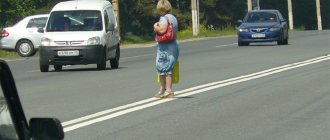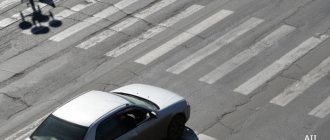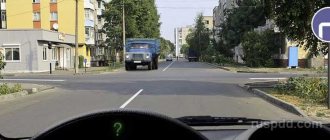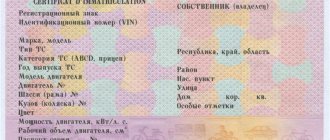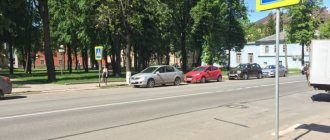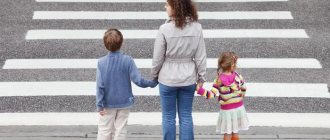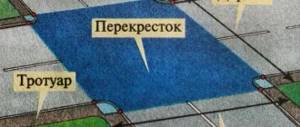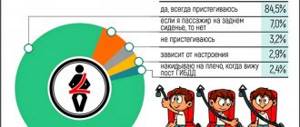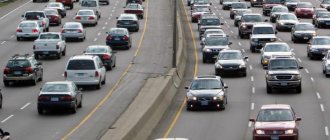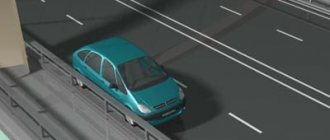Traffic rules of the Republic of Belarus Chapter 15. Pedestrian crossings and stops for route vehicles
114. A pedestrian crossing is indicated by road signs 5.16.1, 5.16.2 and (or) road markings 1.14.1–1.14.3. In the absence of road markings, the width of the pedestrian crossing is determined by the distance between road signs 5.16.1 and 5.16.2, and when road signs are installed only on the transition border external to the center of the intersection, the width of the crossing is determined by the distance between the alignment of the signs and the conditional line connecting the beginnings of the curves edges of the roadway adjacent to the sidewalk.
A pedestrian crossing at which the movement of pedestrians across the roadway is regulated by a traffic controller or traffic light is called regulated.
115. If a vehicle has stopped or slowed down in front of a pedestrian crossing, then drivers of other vehicles moving in adjacent lanes in the same direction can continue moving only after making sure that there are no pedestrians in front of this vehicle.
116. At regulated pedestrian crossings, when the traffic light turns on the permitting signal (the traffic controller gives the permitting signal), the driver must allow pedestrians (pedestrians) to finish crossing the roadway in this direction.
At unregulated pedestrian crossings, the driver of a vehicle, including a tram, is obliged to give way to pedestrians crossing the roadway at an unregulated pedestrian crossing.
117. The driver of a vehicle is prohibited from entering a pedestrian crossing if a traffic jam has formed that will force the driver to stop at the pedestrian crossing.
118. In all cases, including outside pedestrian crossings, the driver must give way to blind pedestrians (pedestrians) signaling with a white cane. The driver of the vehicle must be prepared to slow down or stop to avoid the possibility of hitting road users such as children and pedestrians with mobility impairments.
119. The driver must stop, giving way to pedestrians (walking) to or from a fixed-route vehicle standing at a stopping point (from the doors), if boarding and disembarking is carried out from the roadway or from a landing area located on it . Resuming movement is permitted only after closing the doors of the route vehicle.
120. It is prohibited to get ahead of a moving tram that has its hazard warning lights on (right turn indicator) in the tram stopping area indicated by road sign 5.13 and road markings 1.17.
121. When approaching a stopped vehicle with the identification sign “Transportation of Children” and with the hazard warning lights on, the driver must reduce speed, stop if necessary and give way to pedestrians (pedestrians).
Other chapters of traffic rules of the Republic of Belarus
Chapter 1 Traffic Regulations of the Republic of Belarus General provisions Chapter 2 Traffic Regulations of the Republic of Belarus Rights of road users Chapter 3 Traffic Regulations of the Republic of Belarus Responsibilities of drivers Chapter 4 Traffic Regulations of the Republic of Belarus Responsibilities of drivers and other road users in special cases Chapter 5 Traffic Regulations of the Republic of Belarus Responsibilities of pedestrians Chapter 6 Traffic Regulations of the Republic of Belarus Responsibilities of passengers Chapter 7 Traffic Regulations of the Republic of Belarus Signals of road traffic lights and traffic controllers Chapter 8 Traffic rules of the Republic of Belarus Use of emergency light signals and warning triangles Chapter 9 Traffic rules of the Republic of Belarus Starting movement, maneuvering Chapter 10 Traffic rules of the Republic of Belarus Location of vehicles on the roadway Chapter 11 Traffic rules of the Republic of Belarus Speed of movement Chapter 12 Traffic rules of the Republic of Belarus Overtaking, oncoming passing Chapter 13 Traffic Regulations of the Republic of Belarus Stopping and parking Chapter 14 Traffic Regulations of the Republic of Belarus Driving through intersections Chapter 16 Traffic Regulations of the Republic of Belarus Railroad crossings Chapter 17 Traffic Regulations of the Republic of Belarus Traffic on the highway Chapter 18 Traffic Regulations of the Republic of Belarus Traffic in residential areas Chapter 19 Traffic Regulations of the Republic of Belarus Priority of route vehicles Chapter 20 Traffic Regulations of the Republic of Belarus Use of external lighting devices and sound signals of vehicles Chapter 21 Traffic rules of the Republic of Belarus Towing of motor vehicles Chapter 22 Traffic rules of the Republic of Belarus Training to drive a power-driven vehicle Chapter 23 Traffic rules of the Republic of Belarus Transportation of passengers Chapter 24 Traffic rules of the Republic of Belarus Transportation of goods Chapter 25 Traffic rules of the Republic of Belarus Traffic on bicycles and mopeds Chapter 26 Traffic rules of the Republic of Belarus Traffic of horse-drawn vehicles and driving of animals Chapter 27 Traffic Regulations of the Republic of Belarus Basic provisions for the admission of vehicles to participate in road traffic, their technical condition, equipment Chapter 28 Traffic Regulations of the Republic of Belarus Responsibilities of officials and other persons of motor transport and other organizations to ensure road safety
Pedestrians, be careful! Obeying traffic rules is the responsibility of every pedestrian.
Whatever you say, life sometimes throws up strange stories. For example, I recently observed how, in the evening, a woman of respectable age, despite the dense flow of moving cars, tried to cross the roadway. In response to my proposal to use the pedestrian crossing, especially since the traffic lights were just a stone’s throw away, she heard: “It’s faster.” When I was already standing at the zebra crossing, she made another attempt and finally got across to the other side while the cars were honking. It's good that there were no consequences.
ATTENTION: TRANSITION
In road statistics there are many sad stories involving pedestrians. On the last day of October on Myasnitskaya Street in the regional center in the evening, a car hit a woman. The Grodno woman was crossing the road at an unregulated pedestrian crossing. The retired driver, justifying his action, said that he didn’t notice the pedestrian. The consequences of inattention include serious injuries to a 40-year-old woman and the culprit facing legal proceedings.
– A pedestrian crossing is a place of increased danger. Most of the collisions happen there,
– notes the head of the agitation and propaganda department of the traffic police department of the regional executive committee,
Andrey Tsydik
.
– Drivers approaching a pedestrian crossing must slow down.
But pedestrians also need to be more careful, wear flickers and reflective vests. And for the absence of flickers or crossing the road in the wrong place, a pedestrian can be fined from 1 to 3 basic units. I have personally seen how inattentive pedestrians can be. At one of the unregulated crossings in Grodno on a dark October evening, I watched people crossing the road. Only two of the five, who walked under umbrellas and in hoods, were convinced that the path was safe. And only a few wear flickers.
The carelessness of pedestrians is a serious concern, traffic police inspectors note. Since the beginning of the year, there have been 70 collisions with pedestrians in the region, killing 13 people. Most often, accidents occur at night; half of those who were hit by wheels were not marked with reflective elements.
The careless attitude of people towards their own safety was confirmed by the results of the recent Operation Filter, which took place in the region. During several hours of duty on country roads, traffic police inspectors held more than 40 pedestrians accountable for lack of flicker.
DEGREE OF DANGER
Pedestrians at low temperatures give traffic police inspectors a lot of headaches. Since the beginning of the year, there have been 14 accidents involving drunk pedestrians. The statistics could have been even sadder if not for the traffic police raids. Crews regularly identify drunk citizens who violate traffic rules.
The Citroen driver had practically no chance of avoiding hitting a pedestrian. On a late October evening, he was returning to Grodno and near the Yuzhny market he ran into a man walking along the roadway. The weather was cloudy, in such conditions it was difficult to see a person on the road in the dark: he was not wearing a reflective vest or flickers. The 31-year-old man died on the spot. The examination established that the pedestrian was drunk.
The situation, inspectors believe, can be reversed if everyone who encounters a drunk pedestrian or cyclist on the road reports it to 102.
CAUTION, CHILDREN ON THE ROAD
A fourth-grader from Grodno was motivated by the desire to get home quickly when, getting off the bus, she did not walk along the pedestrian crossing, but ran out onto the road. At this time, a minibus was moving along it. The driver noticed the child when he was no more than two meters away. The schoolgirl was taken to the hospital.
“Decorative stripes with reflective inserts sewn onto the girl’s jacket did not allow the driver to notice her earlier. And there were no other flickers on it,
– says Andrey Tsydik.
– We recommend using flickers in the form of sleeve strips that are visible in the dark from different angles.
And the best thing is a high visibility vest. Parents need to constantly remind their children that the road should only be crossed at a pedestrian crossing. For an eight-year-old Grodno schoolboy, the holidays in the village with his grandfather in the Berestovitsky district ended as soon as they began. The grandfather was repairing a car that was parked on the side of the road, and his grandson was nearby. At some point the boy ran out onto the road. The Volkswagen driver did not have time to react to the sudden appearance of the child. A third-grader ended up in the hospital with a leg injury.
– This confirms that children must be carefully monitored, not left alone, especially on public roads, and repeated with them the rules of safe behavior on the road. Children are active and impulsive; it is difficult for them to correctly assess the traffic situation. Drivers must be extremely careful when making maneuvers in domestic areas, passing pedestrian crossings, roads in rural settlements and near educational institutions, –
added to the traffic police.
Ekaterina Veselukha, “Grodzenskaya Prauda”, November 7, 2021
Recommendations
The pedestrian is always right in this area, as the traffic rules say. The adjacent territory is a special zone; drivers are simply obliged to give way to citizens in this area.
When leaving the surrounding area, you should stop your vehicle in close proximity to the main road - this will allow the driver to see traffic in both directions.
When making a turn from an adjacent area on the left, it is very important to correctly assess the situation. So, you initially need to drive into it in front, but let’s say there’s a pedestrian walking there. As a result, you stop to let him pass, and the car is located across the oncoming lane. Thus, you interfere with the movement of other vehicles. Therefore, before turning into the adjacent area, look to see if there are any approaching pedestrians, cars or animals.
In the courtyards of houses, in parking lots and entrances to gas stations, the rules for vehicles are completely different than on ordinary roads. But the driver cannot always understand whether he is on the roadway or no longer, and how to move along this section. Read the article about how the surrounding area differs, the traffic rules there and mistakes that can lead to fines and accidents.
Read in this article
Lawyer's comment
The method of allowing pedestrians to pass, according to clause 14.1 of the traffic rules, has changed with the latest innovation on November 14, 2014. Previously, the Rules stated that the driver is obliged to “give way” to a pedestrian, but now there is an obligation to “give way”, and you will understand what the difference is below.
If it was allowed, in the absence of people on the roadway, drivers in adjacent lanes to continue driving when stopping or braking a vehicle in another lane. then now all cars that are moving in one direction, without exception, must brake if any of the cars brakes.
He said this only works at uncontrolled intersections. In general, I didn’t prove anything to him. He said: “You have more hemorrhoids. I'll write you a protocol. You go to the traffic police, they will give you from 1500 to 2500, and if you go to court, then the same thing. In general, you will lose time and money going to the traffic police and to court. First, let's study the Traffic Rules of the Republic of Belarus (SDA): in the SDA there is no term YIELD TO PEDESTRIAN, there is a term YIELD THE WAY on which everything is based.
And he assured: no one will fine a driver who is moving in the first row when a pedestrian steps onto the road 5 lanes to his left.
If a pedestrian nevertheless changes speed, then the reason for the change in his speed should be precisely the approaching car, and not any reasons at the request of the pedestrian.
A 99% similar situation happened to me in Gomel. I still write complaints to prosecutors and courts. The traffic police inspector, smiling maliciously, drew up a report on me for no reason. In this sense, chaos is happening here. The only way to get rid of this is a judicial precedent. And the most interesting thing is that in order to file a complaint with the prosecutor’s office you also have to pay money...
IF, DURING CROSSING THE ROADWAY, A PEDESTRIAN IS FORCED TO STOP OR ACCELERATE OR CHANGE THE DIRECTION OF THEIR MOVEMENT BECAUSE OF YOUR CAR, THEN YOU HAVE VIOLATED THE RULES IN PART 9 OF ARTICLE 9.9. or others
“Educational program from Telogreikin”: so what is not allowing pedestrians to pass and is it possible to prove that you are right?
I would not say that the refusal of pedestrians to pass through is widespread and that pedestrian crossings are constantly covered in the blood of innocent victims. And yet, undoubtedly, this violation can be classified as gross, significantly affecting traffic safety. But even here there are some excesses.
Of course, the traffic police pays great attention to the prevention of this violation, and this is wonderful. But it is probably difficult for them to deal with something about which all inspectors have completely different ideas. Professional inspectors have their own more or less clear opinion, and yesterday’s employees of the Security Department, district police officers and all kinds of riot police come to the traffic police with their own understanding of traffic rules and bring this understanding to the masses. But in reality, it turns out to be on a primitive and everyday plane; when communicating, they “float” on the second term and finally “swim” on the semantic content.
Responsibility for the so-called failure to pass is provided for in Part 6 of Article 18.14 of the Administrative Code, where the offense is expressed in “failure to provide an advantage.”
Failure by the person driving the vehicle to comply with the requirements of road signs or markings (except for entering the lane of oncoming traffic) or violation of the rules for the location of vehicles on the roadway, as well as failure by the person driving the vehicle to give priority in traffic to a route vehicle, pedestrians , or others road users - entails a warning or a fine in the amount of one to five basic units .
We open the traffic rules and in paragraph 2.51 we get acquainted with the definition of “advantage”.
Advantage - the right to priority movement in the intended direction in relation to other road users;
Let us take into account in advance the existence of clause 16.2 of the traffic rules.
A pedestrian has the right ... to have priority crossing of the roadway at an unregulated pedestrian crossing, as well as at a regulated pedestrian crossing with a permitting signal from a traffic controller or traffic light.
Hence the most primitive inspector’s understanding: not providing an advantage means not allowing the pedestrian to go first. For him, everything is simple and clear: if the driver went first, then he is a scoundrel-violator. The entire scheme is built on the right of a pedestrian, and for this inspector the distance between objects and grandma’s speed of movement do not matter.
There is a more advanced version of the primitive representation. This is when the inspector believes in the wise sayings of his colonel, former or living, as if in God. He once said and forgot, but his “word of the oracle” continues to live. Hence the very draconian rule: a pedestrian steps onto the crossing - all traffic must freeze. This rule also exists in an adjusted version: if there is a dividing line, then non-passing on the left side does not count. Then the rule of two lanes - supposedly, to determine the driver’s scoundrel, you need to count the lanes between the driver and the pedestrian: two or more - “bounced”, less than two - scoundrel. All these “rules” are united by one circumstance - these are unwritten rules, just someone’s opinion, the idea of an individual, nothing more.
After the pedestrian's rights, let's return to the driver's responsibilities. For example, the very often mentioned clause 100 of the traffic rules.
When turning left or right, the driver is obliged to give way to pedestrians crossing (crossing) the roadway (via a pedestrian crossing, or, if there is none, along the line of sidewalks or roadsides) onto which he is turning, as well as to cyclists and horse riders crossing it, respectively, on a bicycle lane. track and track for riders.
And let’s add clause 9.9 of the traffic rules.
The driver is obliged. .. give way to pedestrians at unregulated pedestrian crossings and regulated pedestrian crossings while drivers and pedestrians receive a permit signal from a traffic controller or traffic light.
In both cases, we are faced with the term “give way”, the meaning of which is indicated in paragraph 2.76 of the traffic rules.
Give way (not have priority) - a requirement that means not to resume traffic, reduce the speed of the vehicle until the vehicle stops, or not to carry out any maneuver (except for the requirement to vacate the occupied lane given by the traffic controller or the driver of an operational vehicle), if this may force another road participant(s) to change direction and/or speed;
As you can see, some vague formulation appears here: “if it can be forced.” And who can determine this “if he can” and with what device? “If it can” begins when we get behind the wheel of a car and ends in the parking lot. Since the assessment criterion “if he can” is not specified, the driver does not consider his passage through the crossing as a failure to pass when the pedestrian does not change the speed and direction of movement. It turns out that the pedestrian remains with his peremptory right of right of way, and the driver sacredly observes the obligation to give way. Both are right, everyone laughs, everyone is happy.
And here are the inspectors - supporters of a harsh interpretation. They say that if a pedestrian has reduced their speed and direction, then this is already creating an emergency situation (and even leading to deprivation, by the way). This wording actually appears in the Code, in the note to Article 18.14.
In this article and Article 18.23 of this Code, the creation of an emergency situation refers to the actions of road users that forced other participants to change speed, direction of movement, or take other measures to ensure their own safety or the safety of others.
Moreover, the traffic rules do not define “emergency situation” or “creation of an emergency situation.” In a strange way, the “pededash” concept migrated to the Code of Administrative Offenses, which has greater legal force than traffic rules. And under this brand “severe interpreters” are ready to cut off heads.
I do not dare to claim that my position is the only correct one. But it exists, and it is like that - today in this intricacy of traffic rules and the Code of Administrative Offenses the devil will break his leg. Probably, it’s time to somehow more simply and clearly define what a non-pass is, for a uniform understanding of it. Thank you for attention.
Vasily TELOGREYKIN Video by the author Special for ABW.BY
PS The other day, our reader sent a video to the editor, which shows how a traffic police car crosses a pedestrian crossing, and it is noticeable how before this the pedestrian decides to slow down, that is, change his speed. So, shall we now regard this as creating an emergency situation? At this rate, half the country could be left without “rights,” including inspectors...
BrestCITY. News
It is not known exactly what traffic police inspectors are guided by in controversial situations, apparently, by their experience and some internal recommendations. The traffic rules clearly and clearly state that pedestrians at a crossing (especially a controlled one) must be allowed through.
Photo from the BrestCITY.com archive
But what if they are far away and the car can pass without creating obstacles for anyone? Definitely - stand, wait and let it pass . Our reader Pavel was convinced of this and decided to share his story:
My name is Pavel. I am a resident of Brest. Driving experience 30 years. I used to respect the work of the traffic police, but in recent years my attitude has changed a lot. Especially after the latest incident that happened on February 10th. I posted a video from my recorder, it clearly shows what happened. Standing at a traffic light, I clearly saw both pedestrians and the traffic police car. I was sure that I was not disturbing anyone, and I yielded to the pedestrians.
But the inspector decided that everything was wrong. I was fined 210t. rubles, and I still can’t understand why? The inspector explained that I had no right to move if pedestrians were at the checkpoint. I realized that it doesn’t even matter where they are moving, the main thing is that they are at the checkpoint. And that they introduced this rule in January last year. And it doesn’t matter how many free lanes there are before them.
Everything was motivated not by traffic rules, but by articles of the Code of Administrative Offenses. So, now traffic rules are no longer the law for drivers? The only thing that matters is how the inspector interprets your violation? For me personally, now the traffic police has completely lost its authority, and I consider all their actions with gifts and flowers on the roads, and the “Mutual Understanding” program, as a circus performance that has nothing in common with real life.
I want to warn all drivers to be careful and attentive. If you do not break the rules, this does not mean at all that you will not be guilty.
Good luck to everyone on the roads. I have attached a receipt for payment of the fine, it has the date and time of the violation.
Here's the story. Actually, many “copies” have already been “broken” around this issue. We recommend that drivers be more careful on the roads and yield to pedestrians in any situation. Especially if you see traffic police officers 
True, passing intersections becomes a certain problem, especially during rush hour, since turning right in a situation like this (as in the video) is quite problematic, given that pedestrians do not care about when to go, and can do this even when blinking green, which is generally prohibited.
But traffic police officers do not often pay attention to such facts. It is not known for certain how many pedestrians were fined who entered the crossing when the green light was blinking, or who were not convinced that exiting the roadway was safe.
On topic - another video from our visitor. It was made on the street. Brest Divisions.
Source of information: Virtual Brest.
02/11/2016.
News on the topic: car, pedestrians Views: Subscribe to Brest News in Google Read BrestCITY in Yandex.News ———————-
The Ministry of Internal Affairs has prepared a new draft of changes to the Traffic Rules. The document underwent public discussion. Let us recall the main innovations.
There will be fewer documents
Among the necessary documents that the driver must have with him are a license, registration certificate and insurance. It is planned to abolish the driver's license coupon and the state inspection certificate.
A medical certificate will only be needed for those who have driver’s licenses issued in Belarus and on the territory of the republics of the former USSR, which do not indicate a validity period.
Personal mobility products
“Personal mobility devices” – this new term is proposed to be introduced into the traffic rules. This refers to devices with a motor whose maximum speed does not exceed 25 km/h. Traffic police will be able to measure the speed of such vehicles using special devices. In order not to exceed the limit of 25 km/h, the traffic police recommend driving with the speed limiter installed.
Owners of personal mobility devices will be treated like pedestrians. They will be able to move on bicycle paths that are structurally separated from the roadway.
In the absence of bicycle paths, it is allowed to ride on such devices on sidewalks, pedestrian paths or roadsides without creating an obstacle for other pedestrians. It is necessary to cross the roadway using personal mobility devices, as well as roller skates or skis, at walking speed, the traffic police clarified.
Innovations for cyclists
Cyclists will be allowed “in some cases” to cross the roadway at pedestrian crossings without dismounting, but at a speed of 3-7 km/h. You only need to dismount when crossing the roadway at an unregulated pedestrian crossing.
When driving on the road at night outside populated areas, the cyclist must wear high-visibility clothing with reflective elements.
Two lane rule
With the introduction of the two-lane rule, drivers need to give way to pedestrians walking along a zebra crossing if the distance between the pedestrian and the car at the intended meeting point is less than two lanes (one lane and tram tracks, one lane and a dividing strip or zone).
Prohibition of driving on one wheel
It is prohibited to ride a motorcycle or moped on one wheel without holding the handlebars or keeping your feet on the pedals or footrest.
By the way, for this, as stated in Article 18.14 of the Code of the Republic of Belarus on Administrative Offenses, a fine of 5 to 10 basic units and even deprivation of a driver’s license for up to six months are provided.
It will also be prohibited to transport drunk passengers on such vehicles, except for side trailers.
Zone with maximum speed limit
It is planned to introduce the concept of a “Zone with a maximum speed limit”. In densely populated areas, it is proposed to set the speed to no more than 30 km/h. And there will be no need to create artificial bumps on the roads and install additional speed limit signs.
dipped headlights
The traffic rules clearly indicate the period when, during daylight hours, low beam headlights or daytime running lights must be turned on to indicate a moving vehicle. This period is from May 25 to June 5 and from August 25 to September 5.
Restrictions for pedestrians
Pedestrians will only be able to use the bike path if there is no pedestrian path or sidewalk.
Persons moving on roller skates, skis, other sports equipment, personal mobility devices when crossing the road at an overground pedestrian crossing at an intersection must move at the speed of a walking pedestrian
Pedestrians will be prohibited from performing actions that threaten road safety when entering the roadway or moving along it. This means that when crossing the road, you will not be allowed to wear headphones, a hood, or look at your phone, as this will distract the pedestrian’s attention
Seat belts and vests
On the roadway, when troubleshooting technical problems, you will need to wear a reflective vest.
Taxi drivers will be required to wear a seat belt when driving in a populated area, even if there are no passengers inside. At the same time, those taking the qualifying practical test for the right to drive a vehicle will be allowed not to wear a seat belt.
Clause 14.1 of the traffic rules - allowing a pedestrian to pass at the crossing
You are obliged to stop or slow down so that the pedestrian crosses the road without changing either the trajectory or speed because of you. Please note that if he changed his mind about crossing and thus changed the trajectory and speed, it is not your fault.
Stone Age!!! A man flew into space more than half a century ago, but we can’t get a person across the road in an organized manner!!! Yes, if you care about pedestrians, then organize the work of traffic lights in such a way that 100% safety is ensured, and don’t put them on "shepherd" to eat "cabbage" while filming a thriller!!! But I don’t let people pass only if there is a traffic island on the road and they haven’t reached it yet. In other cases, sorry, I will stand. Fuck it. Our traffic rules are very vague, and everything will be as the traffic police decides.
According to Mikhail, he was brought to justice for allegedly not letting a person walk from the opposite side of the sidewalk.
Everywhere, including outside pedestrian crossings, the driver must YIELD THE WAY to a visually impaired pedestrian who gives a signal with a white cane or a cane with a high-visibility coating, including one with a reflective element(s).
Conflict situations between drivers and State Traffic Inspectorate employees arise due to the fact that one of the parties misinterprets the situation, namely, misunderstands the very concept of “could” or “could not.”
Please note that we are talking here about a violation by a pedestrian, which specifically cancels his right to move in the intended direction. And, for example, if a drunk pedestrian appeared in a public place, did not look around and was not convinced that the crossing was safe, then this does not deprive him of the right to cross.
The answer can be found in the definition of the term “give way.” In accordance with paragraph 2.76 of the traffic rules, it means that the driver must not resume or continue driving or perform any maneuver if this may force other road users to change direction and (or) speed.
It also follows that there is no obligation to give way in the absence of an advantage. For example, if a pedestrian begins to cross the road at a prohibitory traffic light at a controlled intersection, then you have no obligation to give way to him. That’s why there is no such requirement in the 2021 traffic rules.
The State Traffic Inspectorate carries out traffic coordination in cases not specified by these Rules, as well as when using for experimental purposes technical means of organizing traffic that are not provided for by these Rules and technical regulatory legal acts.
Attention, driver: there is a pedestrian!
The driver behind the wheel of a car must demonstrate attentiveness and coordination of actions every day. You have to be especially vigilant when a pedestrian is walking nearby, because the slightest mistake can cost a person his life. Let's consider how a driver should behave towards a pedestrian.
Pedestrian on the roadway
The roadway is the realm of drivers. A pedestrian can cross it only if necessary and mainly in specially designated areas - pedestrian crossings.
A pedestrian crossing can be regulated (there is a traffic light or traffic controller <*>) and unregulated. It is necessarily marked with a “Pedestrian Crossing” sign and (or) road markings <*>:
| Unregulated pedestrian crossing - "zebra" |
| Unregulated pedestrian crossing in high-risk areas |
| Pedestrian crossing equipped with traffic lights |
The width of the transition can be seen by the markings. If it is not there, the width is determined by <*>:
1) the distance between the “Pedestrian crossing” signs on both sides of the road <*>;
2) if before the intersection the sign is installed on only one side of the road - the distance from the sign to the line that can be drawn from the beginning of the rounding of the edges of the road on both sides at the intersection <*>.
| Picture 1 | Figure 2 |
At a controlled crossing, the following rules apply: - pedestrians have priority if they are given a permitting signal from a traffic light or a traffic controller. In this case, you are obliged to let the pedestrian pass, even if you are also given a permission signal <*>.
Note! Pedestrian priority means the right to priority movement <*>. Drivers are obliged to give way to him, that is, reduce speed until stopping (not perform maneuvers), if failure to perform these actions may force the pedestrian to change speed or direction of movement <*> .
- if you are given a permission signal, you must allow pedestrians who did not have time to finish moving across the road <*> to pass.
At an unregulated crossing you must always give way to a pedestrian <*>. When approaching this crossing, the speed of movement must be such that it is possible to stop when a pedestrian appears on it <*>.
The following rules apply to any pedestrian crossing:
1. If a car driving ahead of you in the adjacent lane has stopped or slowed down in front of a pedestrian crossing, you should also slow down and be prepared to let the pedestrian pass <*>.
2. When in a traffic jam (approaching it), you must remember that you cannot stop at the crossing. If there is a possibility of such a stop, you need to stop before crossing, even if a “window” <*> forms in front of you and the car ahead.
3. At a pedestrian crossing and next to it, the following is prohibited: turning <*>, overtaking <*>, stopping and parking <*>.
You need to be prepared for the appearance of a pedestrian on the roadway even if there is no pedestrian crossing. In such cases, it is also necessary to follow certain rules:
1. You must give way to a visually impaired person who is signaling with a cane <*>.
2. You must be prepared to slow down or stop if there is: - a person with obvious musculoskeletal disorders; - child.
3. You must stop the car and let through pedestrians coming from the side of the doors of the route vehicle (hereinafter referred to as the vehicle) to board or leaving it if it is at a stop: - located on the roadway; - located not on the roadway, but passengers are boarded (disembarked) on the roadway.
You can start driving after the doors of the route vehicle close, the hazard lights or the right turn signal go off <*>.
Note! It is prohibited to get ahead of a moving tram located in the area of a stopping point with the emergency lights or right turn signal on <*>.
4. If you are approaching a vehicle parked on emergency warning lights with a “Transportation of Children” sign, reduce your speed and, if necessary, stop to let children pass <*>.
5. When turning left or right, you must give way to pedestrians crossing the road you are turning onto. It doesn’t matter whether they walk along a pedestrian crossing or without it - along the sidewalk or curb <*>.
Residential, pedestrian zone, as well as the surrounding area
A special vehicle traffic regime is established in residential and pedestrian areas, as well as in adjacent areas (hereinafter referred to as special zones). Unlike the roadway, pedestrians have priority here <*>. You must drive your vehicle through these areas with extreme caution, taking all measures to ensure the safety of pedestrians, cyclists and other road users <*>.
In the zones under consideration, drivers are prohibited <*>: - driving faster than 20 km/h; - transit traffic. For example, a “shortcut” through courtyards; — teach driving a vehicle with an engine (car, motorcycle, etc.); — park a vehicle with an alarm that turns on randomly and continuously sounds, if the driver is aware of its malfunction; - park trucks, buses, tractors and self-propelled vehicles outside special places marked with a “Parking Place” sign, unless this is related to the performance of work.
When leaving a special zone, you must give way to pedestrians, cyclists and horse riders whose path you are crossing <*>.
In the pedestrian zone it is generally prohibited to drive a vehicle, with the exception of <*>: - vehicles of road maintenance and utility services; — cars with a white inclined stripe on the sides and other vehicles serving organizations located in the pedestrian zone and citizens living there; - Vehicles of citizens living in this zone, if there are no other ways to access the house.
When can liability arise?
A driver who breaks the rules may be subject to administrative or criminal liability.
Administrative liability associated with a pedestrian can arise for various reasons: - violation of vehicle traffic rules in residential areas (warning or fine up to 3 BV) <*>.
Reference information The base size is 24 rubles. 50 kopecks
— failure to provide an advantage to pedestrians when it is necessary to do so (warning or fine from 1 to 5 BV) <*>;
— these violations resulted in the creation of an emergency situation, that is, they forced other road users to take measures to ensure their own or others’ safety: change the speed, direction of movement, etc. Here the punishment is more serious: a fine from 5 to 20 BV. In addition, they may be deprived of their rights for up to 2 years <*>;
- violation of traffic rules resulting in minor bodily injury - a fine of 2 to 30 BV or deprivation of rights for up to 2 years <*>.
Criminal liability may arise for violation of traffic rules that results in less serious, serious bodily injury or death of a person <*>.
The owner of the car also bears civil liability if this car causes harm to the life, health or property of others. Since a car is considered a source of increased danger, damage, as a general rule, is compensated regardless of the fault of the vehicle owner <*>. The amount of such liability may be fully or partially covered by auto insurance <*>.
